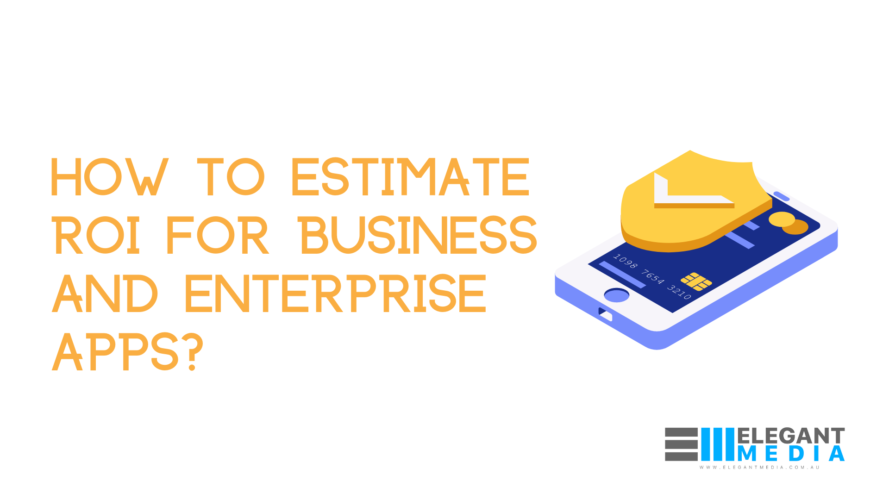A few blog posts ago, we wrote How To Estimate ROI for Mobile Apps. However, this blog post will be different since we are dealing with business Apps, which are Apps designed to sell a product or service, and enterprise Apps, which are Apps designed to offer collaboration and increase productivity in organisations. We will focus on ROI for Business and Enterprise Apps.
We know that a mobile App is in effect an extension of your business. What this means is that with your audience being largely online, it is a matter of catering to this audience in the online sphere. We are talking of business and enterprise Apps, and the framework for measuring the ROI of these Apps will be different from other mobile Apps.
While there are many guides out there that will measure the success of Apps based on different criteria, we are focusing on a certain set of aspects here.
How Do You Measure ROI For Business And Enterprise Apps?
To understand ROI for Business and Enterprise Apps, let’s differentiate between the two.
Let’s take Domino’s Pizza as a business App example, which has a pizza tracker, and which also allows you to order pizzas.
Then, let’s take Slack, which is an internal communications and collaboration tool, as an enterprise App example.
As you would expect, the criteria to assess the success of both types of Apps will vary.
For a business App like Domino’s Pizza, the ROI clearly seems to be on of how many orders have come to fruition via the App.
Whereas, for Slack it is all about efficiency and convenience. There is no doubt that these enterprise Apps are road-tested and far more reliable than consumer Apps.
The reason for this is that enterprise Apps especially cannot afford any downtime time and a buggy experience.
As you would expect, enterprise Apps cost a lot to build and maintain and will require far more effort and investment that a food App.
How Do The Metrics Differ When It Comes To ROI?
This is the conundrum, isn’t it? We’ve got a business App on one side and an enterprise app on another side. What metrics should we be considering?
The metrics are rather different since these types of Apps are worlds apart. On one hand, we know that business Apps are considered successful based on how much revenue such an App generates.
As per our earlier example, an online pizza App would be based on the number of orders it generates. Having said that, it should be an App that is so easy to navigate, offers a great user interface and an awesome user experience.
Additionally a business App is all about transactional convenience. Does it offer a user to quickly swipe through the menu and order the desired options easily and securely? Security and privacy is also an important talking point, but this is something that is relevant to enterprise Apps as well.
The metrics when it comes to enterprise Apps is also about convenience. However, most enterprise Apps are about collaboration, teamwork, and easy integration for the sake of productivity. For example, Slack can integrate with Google Drive.
This is important since it helps with streamline the storage of files and offers efficient file retrieval.
Remember, that there is also the cost of development and that of maintenance that needs to face consideration.
But, in this blog post, this is not an area that we are looking into.
This is How you Measure ROI for Business Apps
The metrics that need to be looked into are:
- Number of Downloads
- Number of Sales
- App Churn
- Cost per Acquisition
- Number of Active Users
Let’s look into each section separately.
- Number of Downloads
The number of downloads of an App is an essential metric when you are dealing with a business App. The number goes up exponentially once downloads become much larger, and a good marketing budget is used to ensure that you gain a great deal of users.
- Number of Sales
Whether you are selling pizza or burgers, the number of units sold is surely your main KPI. It would be fair enough to make the claim that this is something that is interlinked to so many other variables when creating an App.
- App Churn
App churn rate can be regarded as the percentage of users who uninstall or stop engaging with an App over time. This is a vital metric since if there are issues with the App like, say for instance, it is buggy, then you need to ensure that it offers a seamless and user friendly experience.
4. Cost per Acquisition
This metric determines and calculates the monetary amount required to acquire a customer by means of an App. It helps an organisation to decide whether they should invest more time and money into improving their App or to create a new one.
5. Number of Active Users
Active users is a measurement metric that is commonly used to measure the level of engagement for a particular product or service. The more time spent on the App the better for you. This is something that is vital since it reflects the fact that you have achieved a great deal of engagement and interest.
This is How you Measure ROI for Enterprise Apps
The metrics that need to be looked into are:
- Efficiencies
- CCP (Collaboration, Communication & Productivity)
- Increased Sales
- Platform Churn
- Be The Benchmark
Let’s look into each section separately.
- Efficiencies
There are different formulas that need to be used in order to assess ROI. However, with regard to the concept of efficiencies, there are factors that are tangible and intangible. For instance, the automation of processes, quicker collaboration and better communication plus an increase in sales due to these synergies are metrics that need to be considered. How to assess these efficiencies are based on internal formulas that need to be considered with HR and IT weighing in.
- CCP (Collaboration, Communication & Productivity)
As an enterprise App, factors like the frequency of use, how much time is saved and the number of tasks have been completed must be considered. As a simple example, instead of maintaining an email trail with regard to a company annual trip, opening up a Slack channel for real-time conversation would be a serious time-saver.
- Increased Sales
This really does not need much explanation. There are enterprise products like Slack and Microsoft 360 that require the seamless integration of their Apps. This is something that must be taken into consideration since productivity is a game where being mobile is part and parcel of having a great experience.
- Platform Churn
There is a theory that enterprise Apps face a great deal of churn.This is a huge cost at the end of the day, and is something that needs to be mitigated. How this is done by ensuring a new spate of features are brought out and tested. Consider all the popular social media Apps that are always bringing out new features that they keep on testing. All of this trouble is for user engagement.
5. Be The Benchmark
Although this is rather intangible, how you could measure the success of your enterprise App is through the amount of awards it wins and the number of positive reviews it gets. Be the enterprise App that makes your competitors jealous and the talk of the town.
Conclusion
Business Apps and enterprise Apps are big business, and are part of the online world, which is helping to drive a lot of profitability for the companies that are involved. We know this. What metrics and what areas to assess are important, but it is all down to what the audience of such Apps find important. Business Apps like a Pizza Hut App may find its viability in the number of orders it manages to transact. While enterprise Apps are going to be more concerned about churn and how many new customers it gets.






